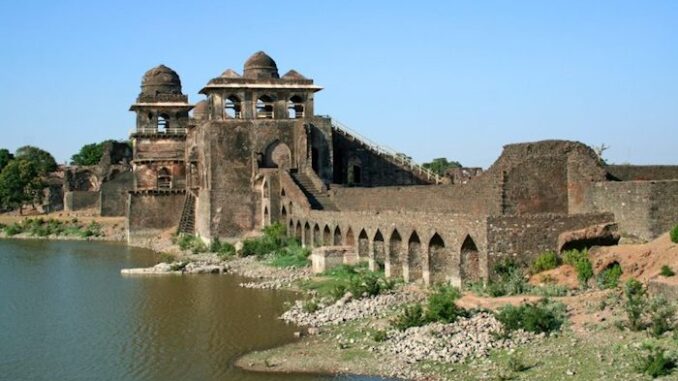
If we had researched on the Internet, we would have realized that monsoons are the best time to visit Mandu. We visited this medieval city, the jewel of Malwa, during the Diwali weekend. A 14-hour journey by night train from Delhi took us to Indore, the most convenient railhead, 100 kms from Mandu. From here, it is a three-hour road journey to Mandu, via the military town of MHOW, an acronym for Military Headquarters of War.
The hill-fort of Mandu is separated from the main plateau of Malwa by a deep ravine, called the Kakra Khoh, which encircles it in three directions and finally vanishes into the Nirmar plain on the southern side. Just before entering the fortified city, there is a fossil museum, which we found closed. We stopped here to view the magnificent Kakra Khoh gorge. After this, we enter the fort through a series of arched gates, viz. Alamgir Gate, Bhangi Gate, Karnani Gate and Gada Gate. As we reach the market place, we come across a few abandoned monuments before getting a glimpse of the Jami Masjid & Ashrafi Mahal before going further into the fort, to reach the Royal Enclave.
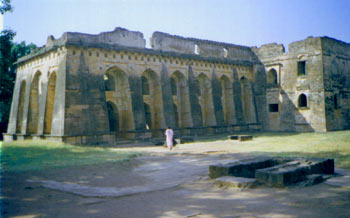
The Royal Enclave houses several monuments belonging to different eras. The prime attraction is the Jahaz Mahal, which is flanked on two sides by two tanks called Munj Kund & Kapur Kund, which give it the appearance of an anchored ship. Jahaz Mahal was built by Sultan Ghiyathuddin Khalji some time in the late fifteenth century AD. During one of the Deccan sojourns of the Mughal Emperor Jahangir, his beloved queen Nur Jahan resided in this palace.
The Jahaz Mahal truly reflects the spirit of romantic beauty and joyous hilarity so characteristic of the palace life of the Muslim rulers of India. Here grand functions were held, about one of which the emperor writes in his memoirs: “It was a wonderful assembly. In the beginning of the evening they lighted lanterns and lamps all round the tanks and buildings and a lighting up was carried out the like of which has perhaps never been arranged in any place. The lanterns and lamps cast their reflection on the water and it appeared as if the whole surface of the tank was a plain of fire. A grand entertainment took place and the drunkards indulged themselves to excess ”
Very close to the Ship Palace is another architectural masterpiece, Hindola Mahal, attributed to the reign of Ghiyathuddin Khalji. Literally meaning the “Swinging Palace”, the name was earned because of its peculiarly sloping sidewalls. The architects succeeded in their aim to build a structure dignified and simple, yet majestic in appearance, worthy of being used as the great Audience Hall of the Sultans.
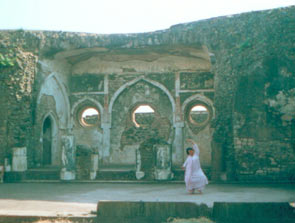
Beside the Hindola Mahal, by the banks of the Munj Kund are a group of several ruined structures lying in confusing disarray giving no indication of their original layout or plan. Among these is a wellcalled Champa Baori, which because of the sweet flavor of its water is said to smell like the champak flower. Also notable is the Royal Sauna called Hammam, which reflects the sophistication of bathroom technology in that age. We are also amazed to discover a medieval open-air theatre nearby, which prompted me to goad my dancer wife to strike an Odissi pose.
Another ruined structure here is the Nahar Jharokha or the Tiger Balcony, which was basically meant for the rulers to address their subjects. Apparently, it was here that Emperor Jahangir happily conferred the title of Shah Jahan (or King of the Universe) upon his son Prince Khurram, after the latter presented the emperor with over Rs 23 lakhs, either through booty in some Deccan conquest or through tax collection.
Beside the Tiger Balcony stands the Dilawar Khan’s Mosque, which is the earliest Indo – Islamic building at Mandu, made during the reign of Dilawar Khan Ghuri, the first known Muslim ruler of Mandu. Dilawar Khan, who was appointed the Governor of Malwa by Emperor Mohammad Bin Tughlaq seized the opportunity to assume charge of Malwa and declare independence when Delhi was going through a period of political instability. Though he had his capital at Dhar, around 40 kms away, he used to frequently visit Mandu and often held court here.

A striking feature of the architecture of the Royal Enclave buildings is the presence of a number of floral shaped channels to carry water, which ended in artistically shaped pools, presumably meant for the lotus to bloom. We found that the pools were empty and realized that during the rains the pools would add to the romance of the place.
Prior to the rule of the Moslems, Mandu or ‘Mandapa Durga’ as it was called earlier, is said to have been found and ruled by the Hindu Parmara kings. Barring the Lohani caves, there isn’t much evidence in the ruins to trace their history. For all practical purposes, the history of Mandu begins with the establishment of the Ghuri dynasty by Dilawar Khan.
After spending close to two hours at the Royal Enclave, we moved to the next cluster of monuments, located near the market place. We visited the Tomb of Hoshang Shah, perhaps the only full-fledged structure in marble. Apparently, this beautiful edifice is India’s first marble building and was the model that inspired the architects of the Taj Mahal. Hoshang Shah was the son of Dilawar Khan and he is said to have reigned for nearly 3 decades. The fort boundary walls were also erected during his reign. After Hoshang Shah’s death in 1435 AD, his son Mahmud Shah ascended the throne, but his reign was short lived as he was poisoned to death by his namesake and confidante. This marked the end of the Ghuri dynasty and the beginning of the Khalji dynasty rule of Malwa.
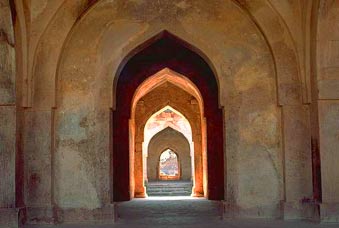
Just beside Hoshang Shah’s tomb is the Jami Masjid, which was also erected during his reign. Opposite the Jami Masjid are the ruins of the Asrafi Mahal or the Madrasa, which was built during the reign of Mahmud Shah, the first Khalji dynasty ruler. Mahmud Shah, perpetually engaged in Military expeditions, commemorated one of his victories over the Rana of Mewar, with a magnificent seven-storied tower of which only the basement now survives. Currently, almost the entire area around the Ashrafi Mahal is in a state of ruins. It may be noted that Mahmud Shah was succeeded to the throne by his son Ghiyathuddin Khalji, who reportedly built the Jahaz Mahal as shelter for his harem of fifteen thousand. The Khalji dynasty ended in 1526 AD when Ghiyathuddin’s son was overthrown by Bahadur Shah of Gujarat.
Bahadur Shah was overthrown by Mughal Emperor Humayun in 1534 AD. However, once Humayun left, the fort was taken over by an officer of the former dynasty. The fortunes of the rulers of Mandu fluctuated for the next two decades before Baz Bahadur seized power in 1554.
Bahadur Shah was overthrown by Mughal Emperor Humayun in 1534 AD. However, once Humayun left, the fort was taken over by an officer of the former dynasty. The fortunes of the rulers of Mandu fluctuated for the next two decades before Baz Bahadur seized power in 1554.
After seeing the monuments scattered in the neighborhood of the market, we proceeded towards the cluster of monuments near the water reservoir “Rewa Kund”, attributed to the period of Baz Bahadur’s rule. After a humiliating defeat at the hands of Rani Durgavati of Indore, Baz Bahadur is said to have lost interest in warfare and devoted most of his energy to poetry, music and romance. On the lofty crest of the hill, above Rewa Kund, stand the pavilions associated with the romantic name of Rani Rupamati. It was from here that the queen poetesses would offer her prayers to the sacred Narmada river. The Rupamati Pavilion offers the viewer a panoramic view of the entire Nirmar plains. About half a kilometer below is the Baj Bahadur palace, which is adjacent to the Rewa Kund reservoir. This royal residence of Sultan Baj Bahadur is said to have been witness to the king’s glorious romance with his consort Rani Rupamati, the tales of which are today a part of the folklore of the region. Their love story can be distinctly felt in the surrounding silence.
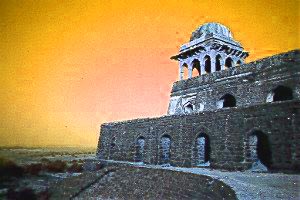
In 1561, Baz Bahadur fled Mandu before Akbar’s troops reached the kingdom and captured it.
We stopped at Nilkantha, which houses an ancient Shiva temple within a Moghul styled arched structure, which was added later during Emperor Akbar’s visit. From here, one can get a great view of the green hillscape and enjoy the sitaphal being sold by the local women folk.
Close to evening we quickly approached our final destination for the day, the Sagar Talao cluster of ruins. A signboard indicates the presence of an Echo point. As we entered the first monument, we tried in vain to experience the intended resounding effect. As we come out of the building, we spotted a few other buildings further ahead. The next structure is called Dai ka Mahal or the Nanny’s palace and we learnt that it was the residence of the women who breast-fed the infants of the rulers of Mandu. These nannies are supposed to have enjoyed a very high social status. Much of the building is in a state of ruins, though we did finally get to enjoy the resounding echo in one of these structures.
The architecture in Mandu is predominantly in the Indo-Islamic style, right from Dilawar Khan’s period till the Mughal rule. The fort continued to be ruled by Mughals till the early part of 18th century when it passed into the hands of the Marathas in 1732 after the Mughal hold weakened when the capital of Malwa was shifted back to Dhar and Mandu became a ghost town. Despite being abandoned for the past four centuries, there is enough romance in the ruins to capture the imagination of the visitor.
The renowned historian Daniel J. Boorstin said:
“The traveler was active; he went strenuously in search of people, of adventure, of experience. The tourist is passive; he expects interesting things happen to him. He goes ‘sight-seeing’.”
Such is the compelling medieval aura of Mandu that the sight seeing tourist in us is momentarily transformed into the quintessential adventure seeking traveller as we step through the pages of history, seemingly reliving the lives of those whose memories haunt the ruins of palaces.
Photo Credit: Pinaki Das

Leave a Reply